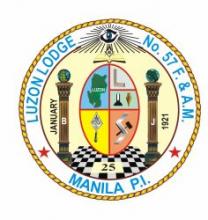
Luzon Lodge No. 57
The Name
This lodge was originally called "Isla de Luzon," after the Island of Luzon, on which Manila, the seat of this lodge, is situated. During the Commonwealth era, its name was changed to Commonwealth Lodge, but shortly before the proclamation of Philippine Independence on July 4, 1946 the lodge changed its name to Luzon Lodge.
In his work on the Philippines published in 1846, Jean Mallat relates how Luzon got its name, thus:
This island was so called because, it was noted that in front of each but of the inhabitants, there was found a big cylindrical wooden mortar in which (as it is still done) rice was pounded, cleaned and later cooked as the principal food of these people. These mortars were called, in their language, losong.
The Lodge
In the March 1931 issue of The Cabletow, it is reported that then Assistant Grand Secretary Ramon Mendoza, who was also the Master of Isla de Lu-zon Lodge, compiled all available documents on the "organization, founding and constitution." of the lodge. The documents show that the lodge got ,its start in a meeting of several Masons in a house along NO. 115 Calle Villalobos in Quiapo. In another meeting held in the residence of Brother Gonzalo Libunao at 1045 Arlegui-St., Quiapo, the petition for dispensation was prepared and signed. At exactly 12:40 pm on February 13, 1920, Grand Master Rafael Palma affixed his signature to the dispensation that gave life to the lodge. Twenty-eight brethren signed the petition, 27 of whom were from Biak-Na-Bato Lodge and one from Araw.Lodge No. 18. Among the petitioners Were: Ladislao Jose,(Dailmacio V. Monroy, Francisco Gumila Carag, Gonzalo B. Libunao and Luis Lim-Bilian. Carag was designated as the Master of the lodge UD. On January 25, 1921, during the annual communication of the Grand Lodge upon the( favorable recommendation of the Committee on Charters, Isla de Luzon Lodge No.57 was granted a charter.
On February 10, 1921, Grand Master Edwin E. Eiser, accompanied by Manuel Camus, Frederic H. Stevens, Elias Asuncion, Newton C. Comfort, Julian Balmaceda and other Masonic dignitaries constituted isla de Luzon Lodge No. 57 at the Scottish Rite Hall of the Masonic Temple at the Escolta and immediately thereafter installed its officers. The ceremonies were public and were followed by a musical entertainment and dance and a banquet. The attendance was very large.
The roster of Isla de Luzon Lodge was never big. Its average number of members before the outbreak of World War II was just a little over 30, although in 1923 it had 64 on its roster. Among those who joined this lodge were PGM Antonio Gonzalez, Nicanor Abelardo, Antonino Buenaventura , Feliciano Balingit, Teodoro Arnesto, Ambrosio S. Tesforo, Hilario M. Soriano, Jose M. E. De Leon, Vicente P. Flechero, Juan Cortes, Apolinario Roldan, Antonio C. Perez, Leonardo Fajardo, and Dr. Jose Paterno. Francisco Villa, the Patron of the famous world-boxing champion, Pancho Villa, was also a member of the lodge.
Before the War, Isla de Luzon lodge was known as a lodge of musicians. Its most famous members were Nicanor Abelardo of Kundiman fame and Col. Antonino Buenaventura, conductor of the Philippines Constabulary band The members who were musicians often provided the entertainment during lodge affairs. Thus, during the installation of officers of the lodge in 1930, the quests were regaled with musical selections from the compositions of four of the members of the lodge, Abelardo, Balangit, Buenaventura and Arnesto.
Abelardo never Occupied the oriental chair, but time and again he showed his love for his lodge. Even when he was out of the country, he constantly got in touch. In 1930, he composed Marcha Triunfal which he dedicated to Isla de Luzon Lodge. In that year too he composed his prize winning Himno Masonico.
When the Philippine Constitution of 1935 was ratified and the country became a Commonwealth, the members changed the name of their lodge to Commonwealth Lodge.
The lodge closed when the Great Pacific War broke out in December 1941, but it was reestablished upon the restoration of peace. On August 30, 1945, WB Jose M. E. de Leon called the surviving members to a caucus in the office of the Grand Master. Aside from reestablishing the lodge, the members adopted a resolution changing the name of their lodge to Luzon Lodge. The decision was no doubt prompted by the fact that the Commonwealth era was about to end with the forthcoming proclamation of Philippine Independence on July 4, 1946.
In the 1980's the lodge went through hard times. Attendance dwindled, but Past Masters Charlie U. Tang, Roberto Palmero, Jesse D. Alto, Francisco Gudani, Pedro M. Curva and Renato Crisologo refused to throw in the towel. They stubbornly labored to revitalize the lodge. Eventually their efforts paid off. By the time the members celebrated the 75th anniversary of their lodge in 1995, under the able leadership of Julian Teodoro and the indefatigable Robert C. Ocampo, the lodge was firmly on its feet. Among the others who are now helping in maintaining a steady course for the lodge are Hernani T. Barrios, Jonathan de Belen, Frederick de Belen, Jose Ong, George Inigo and Dino Valdez.
Location: Plaridel Masonic Temple, Manila
 The Most Worshipful Grand Lodge of Free and Accepted Masons of the Philippines
The Most Worshipful Grand Lodge of Free and Accepted Masons of the Philippines